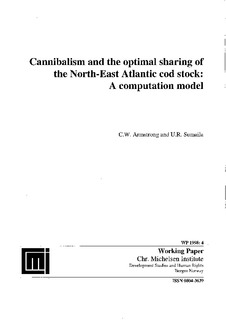Cannibalism and the optimal sharing of the North-East Atlantic cod stock: A computation model
Working paper
Permanent lenke
http://hdl.handle.net/11250/2435762Utgivelsesdato
1998Metadata
Vis full innførselSamlinger
- Bora-import [434]
Sammendrag
This paper shows how intra-stock relations, such as cannibalism and growth enhancement, definethe optimal sharing of a fish resource between heterogeneous harve sting agents. The sharing ofresources between different vessel groups is often left for political decision making. Nonetheless,such decIsions may have both biological and economic consequences. This becomes quite clearwhen different harvesting groups exploit different sections (age groups) of a stock that hasintra-stock interactions in the form of cannibalism. A two-agent bioeconomic model withcannibalism is developed and used to determIne (i) optimal annual harvest sizes (T ACS) for cod,and (ii) the optimal proportion of the T AC that should be harvested by the trawler and coastal fleets.Applying biological and economIc data in a numerical procedure, and comparing the resultsobtained to previous studies, it is shown that the presence of cannibalism has a significant impact onwho should take what proportion of the T AC, and hence, the standing stock size and discountedeconomIc rent achievable. In sharp contrast to other studies, we find that the optimal harvestrequires that both trawlers and coastal vessels should harve st the fish resource. In addition, theresults indicate that from a bioeconomic perspective, the existing trawler fleets harvest share in thecod fishery is too high.
Utgiver
Chr. Michelsen InstituteSerie
CMI Working paperWP 1998: 4
